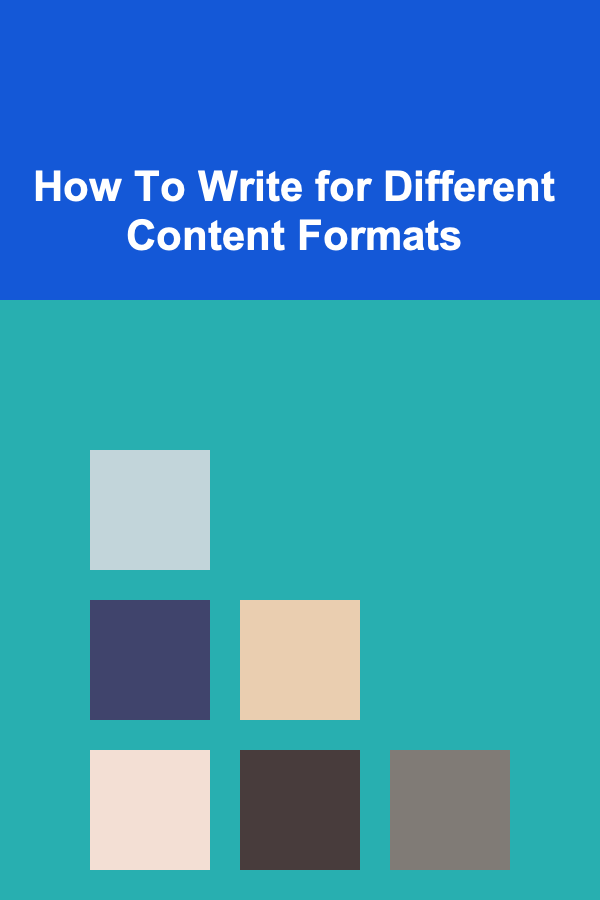
How To Write for Different Content Formats
ebook include PDF & Audio bundle (Micro Guide)
$12.99$6.99
Limited Time Offer! Order within the next:

Writing is an essential skill that adapts to various formats, each demanding a unique approach, tone, and structure. Whether you are drafting a blog post, a social media update, a product description, or a formal whitepaper, each content format serves a different purpose and audience. Understanding how to tailor your writing for these diverse formats can greatly enhance your effectiveness as a content creator. In this article, we will explore how to write for different content formats, emphasizing key strategies for success in each.
Understanding Content Formats
Content formats can be broadly categorized into two main types: short-form content and long-form content. Short-form content is typically concise, aiming for quick engagement or providing an immediate takeaway. Long-form content is more detailed and in-depth, often requiring extensive research, structure, and narrative. Some examples of common content formats include:
- Blog posts
- Social media posts
- Product descriptions
- Email newsletters
- Whitepapers
- Case studies
- Ebooks
Each of these formats serves a distinct purpose and requires a specific approach to writing. The following sections will break down key strategies for writing effectively in each format.
Writing Blog Posts
Purpose
Blog posts aim to inform, entertain, or persuade readers, often written in a conversational tone. A blog post should provide value and engage the reader while being informative and easy to read. Blogs are typically more casual and personal than academic writing, making them a great space for creativity and storytelling.
Structure
A well-structured blog post follows the AIDA framework---Attention , Interest , Desire , and Action. This structure helps create an engaging flow:
- Headline: The headline is the first thing the reader sees, and it needs to be attention-grabbing. A good blog headline is clear, concise, and directly speaks to the reader's interests or problems.
- Introduction: The introduction should hook the reader, presenting a problem or question that the blog will address. A compelling introduction invites readers to keep reading.
- Body: The body is where the bulk of the information is presented. It should be well-organized, with short paragraphs, headers, and bullet points to improve readability. Include examples, images, and statistics to add value.
- Conclusion: Summarize the key points and end with a call to action (CTA). A CTA encourages readers to take the next step, such as subscribing to a newsletter, purchasing a product, or sharing the blog on social media.
Tone
Blog posts tend to have an informal tone, but this can vary depending on the audience. For instance, a blog on professional development might lean toward a more formal tone, while a travel blog might adopt a lighter, conversational style. It's crucial to match the tone with your target audience's expectations.
Writing Social Media Posts
Purpose
Social media posts are often short, to the point, and intended to engage users quickly. The goal is to provoke a reaction, whether it's a like, comment, share, or click. Social media content should also encourage interaction and foster community, rather than just promote products or services.
Structure
Social media content is usually brief, so each word matters. It's essential to:
- Hook the Reader Immediately: Social media users scroll quickly, so your first sentence or phrase should grab their attention.
- Use Visuals: Posts that include images, videos, or infographics perform better because they stand out in a crowded feed.
- Call to Action: A CTA in social media content may prompt users to comment, share, or visit a website. The CTA should be clear and compelling.
Tone
The tone of social media posts can vary depending on the platform and brand. On Twitter, the tone is often witty and concise, while Instagram might focus on a more visual, emotionally engaging tone. LinkedIn tends to lean toward a more professional, polished style, and Facebook strikes a balance between casual and formal.
Tips
- Keep it Short: Twitter limits characters, while other platforms, like Instagram, allow for longer posts. However, it's essential to stay concise wherever possible.
- Use Hashtags and Mentions: Hashtags help increase visibility, and tagging other users can foster interaction.
- Engage with Your Audience: Social media is about conversation. Responding to comments and messages helps build community.
Writing Product Descriptions
Purpose
Product descriptions aim to sell a product by highlighting its features, benefits, and value. The goal is to inform the customer while persuading them to make a purchase. Good product descriptions paint a picture of how the product will enhance the customer's life.
Structure
- Headline: A strong product title immediately grabs attention and should be clear, including key details (brand, size, model, etc.).
- Features: List the product's main features, such as size, material, color, and specifications.
- Benefits: Explain how the product solves a problem or improves the customer's life. Focus on the emotional appeal.
- Call to Action: End with a clear action prompt, such as "Add to Cart" or "Buy Now."
Tone
The tone for product descriptions is usually more direct and persuasive, using language that emphasizes the benefits and quality of the product. You want to evoke a sense of urgency or desire without being overly pushy.
Writing Email Newsletters
Purpose
Email newsletters aim to communicate important information to subscribers, build relationships, and keep readers engaged with the brand. They can serve many purposes, from sharing company news and updates to promoting products or content.
Structure
- Subject Line: The subject line is crucial to getting your email opened. It should be compelling and encourage the reader to click. Keep it short and to the point.
- Introduction: The introduction should briefly explain what the email is about and provide context.
- Body: Provide value by offering useful information, tips, or resources. Keep paragraphs short and use headings to break up the text.
- Call to Action: Include a CTA, such as encouraging the reader to visit your blog, check out a new product, or share the email with friends.
- Signature: End the email with a signature that reinforces your brand's personality and identity.
Tone
Email newsletters should be friendly and conversational but maintain a sense of professionalism. Since email is a more direct form of communication, you want to make the reader feel personally addressed.
Writing Whitepapers
Purpose
A whitepaper is a detailed, authoritative report or guide that provides in-depth information on a specific topic. It is typically used to educate the reader, provide solutions to a problem, or present research findings. Whitepapers are often used in B2B contexts to generate leads and demonstrate expertise.
Structure
- Title: The title should be informative and direct, highlighting the key focus of the paper.
- Abstract: Provide a brief overview of what the whitepaper covers and why it matters.
- Introduction: Introduce the problem, provide background information, and set the stage for the paper's argument or research.
- Methodology/Findings: This section includes detailed research, case studies, or data analysis to support the whitepaper's argument.
- Conclusion: Summarize the key findings or recommendations and suggest next steps for the reader.
Tone
Whitepapers should be formal and authoritative. The tone is informative and professional, backed by data and research. Avoid conversational language or overly promotional content.
Writing Case Studies
Purpose
Case studies focus on providing real-world examples of how a product, service, or solution solved a problem for a client. They are valuable tools for building credibility and trust.
Structure
- Introduction: Introduce the client, their problem, and the context.
- The Challenge: Describe the problem or challenge the client faced before implementing the solution.
- The Solution: Detail the solution provided, including the product or service used and how it addressed the issue.
- Results: Highlight the results achieved, often using metrics or quotes from the client.
- Conclusion: Wrap up with a summary and perhaps a CTA for potential clients to inquire further.
Tone
The tone of a case study is typically formal but can be slightly conversational, especially when quoting the client. The language should be clear and professional, with an emphasis on results.
Writing Ebooks
Purpose
Ebooks are long-form content pieces that provide in-depth exploration of a specific topic. They are often used as lead magnets or educational tools.
Structure
- Title and Cover: A compelling title and cover are essential for attracting readers.
- Introduction: Outline the purpose of the ebook and what the reader can expect to learn.
- Chapters/Sections: Break down the content into digestible chapters, each focusing on a specific aspect of the topic. Use headings, subheadings, and bullet points to make the content easy to read.
- Conclusion: Summarize the key takeaways and include a CTA for the reader to take further action, such as purchasing a product, signing up for a course, or engaging with more content.
Tone
Ebooks typically adopt a more educational tone. While they are generally more formal than blog posts, they should still maintain a conversational style that encourages reader engagement. It's essential to balance professionalism with approachability.
Conclusion
Writing for different content formats requires understanding the unique characteristics and objectives of each format. Whether you're drafting a blog post, social media update, or whitepaper, tailoring your approach to the format can improve your writing's effectiveness and impact. By following the strategies outlined in this article, you can ensure that your content is engaging, informative, and relevant to your audience, no matter the format.

How to Create the Perfect Lighting for Movie Nights at Home
Read More
How to Optimize Your Shower Space with Smart Storage
Read More
How to Simplify Your Errands and Tasks
Read More
How to Use Color-Coding for Toy Storage Solutions
Read More
Performance Management Success Strategies for Human Resources Assistants
Read More
How To Master Cross-Functional Leadership
Read MoreOther Products

How to Create the Perfect Lighting for Movie Nights at Home
Read More
How to Optimize Your Shower Space with Smart Storage
Read More
How to Simplify Your Errands and Tasks
Read More
How to Use Color-Coding for Toy Storage Solutions
Read More
Performance Management Success Strategies for Human Resources Assistants
Read More